7th International Python Conference
Executive summary

-
Python is a young scripting language
that has got most of its design trade-offs exactly right. It has a clean
and coherent core supported by an extensive and rapidly growing library
that, in fewer years, has already grown to be much more comprehensive than
Tcl's, primarily thanks to Python's
more bazaar-oriented development model (see my own paper
for more on this). Python is technically good, very versatile (it does CGI,
CORBA,
OLE/COM, XML, Java integration, Windows CE,
number crunching, image
processing, sysadmin stuff, you name it...) and has the potential to
become something big (language inventor Guido van Rossum, now at CNRI, is supported by
technovisionary Albert Vezza, the man who hired Tim Berners-Lee from CERN
to MIT to form the W3C consortium). Watch Python grow. Use it. Benefit from
it.
-
XML, a markup language to
represent documents textually in a structured way, is serious stuff. A
common and self-describing interchange format for data. If it all works
out, it will be as ubiquitous as ASCII is today. And Python groks XML well.
-
30-minute slots for conference talks (questions included) are a lot better than 60-minute ones. They force the speaker to cut the crap and stick to the interesting parts. I wish they were much more widely adopted.
-
Python demi-god and Pythonwin
creator Mark
Hammond is going to get paid (by a bank) to finally write proper
documentation for his baby!
50 * ";-)"
-
The Open Source software
development model has its full-time evangelist: Eric Raymond; some of us knew
already, but it's still great to finally shake hands
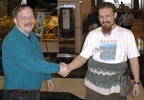 with the man. Read
his insightful papers The
cathedral and the bazaar and Homesteading the
noosphere (plus two more in the pipeline). You might also be interested
in the Halloween
documents, about Microsoft's view on the Open Source "threat". Eric is
finally being noticed not just by the press but by the people with the
money: a phone conference was scheduled for the 18th of November for him to
speak to an audience of 75-100 venture capitalists, each worth > 100
M$. Summary: Open Source is better for reliability, cost of ownership,
strategic business risk.
with the man. Read
his insightful papers The
cathedral and the bazaar and Homesteading the
noosphere (plus two more in the pipeline). You might also be interested
in the Halloween
documents, about Microsoft's view on the Open Source "threat". Eric is
finally being noticed not just by the press but by the people with the
money: a phone conference was scheduled for the 18th of November for him to
speak to an audience of 75-100 venture capitalists, each worth > 100
M$. Summary: Open Source is better for reliability, cost of ownership,
strategic business risk.
-
Contrary to what Guido seems to be saying on his web page, the official
pronunciation for his name is not "parapa-RA-pa". See below.
-
The Python conference had a very high density of cool people doing interesting work.
Having had not one but three contributions accepted, I had no excuse not to
attend the 7th
International Python Conference in Houston (actually League City),
Texas. About 100 people. Mostly white males: women, blacks, asians were all
< 5% each, which I found slightly disappointing -- I hoped that Python
might cover a broader spectrum. No suits. "Strong refereeing process" for
the papers, said the program chair, compared to previous years.
Python
For those who don't know yet, Python is a high-level scripting language
like Tcl and Perl. It is elegantly designed and very readable (thanks in
part to its indentation-based syntax, à la Occam). Like other scripting
languages it offers powerful primitives (sort, regular expressions...) and
data structures (lists, associative arrays...). As I argued in the final
section of the paper I presented, it is better suited than Tcl to the
development of large software projects thanks to its object orientation,
its support for modularity and embedded documentation, and particularly its
rich standard library, which makes it even more of a practical
very-high-level language. Compared to Perl, it is just as flexible and
versatile, but it's easier on the brain: you can read the source code and
it makes sense, and the language has a coherent design. Biased opinion, of
course, but what else did you expect?
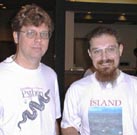 Python is younger, less used and less known than Tcl. This is something
that I palpably perceived at the conference, much more so than in the
newsgroup. The user community is quite small, still mostly geeks and very
few big players. Still, I rate it as a good penny-share bet: the language
has the potential to grow into something very successful. It has a more
bazaar-like slant than Tcl, which means that it improves at a faster rate
(if you haven't read Eric Raymond's eye-opening The
cathedral and the bazaar paper on the development patterns of free
software, do so: it provides unique insights).
Python is younger, less used and less known than Tcl. This is something
that I palpably perceived at the conference, much more so than in the
newsgroup. The user community is quite small, still mostly geeks and very
few big players. Still, I rate it as a good penny-share bet: the language
has the potential to grow into something very successful. It has a more
bazaar-like slant than Tcl, which means that it improves at a faster rate
(if you haven't read Eric Raymond's eye-opening The
cathedral and the bazaar paper on the development patterns of free
software, do so: it provides unique insights).
 As I discovered at the conference, on the organisational front Python has
the backing of Albert Vezza (ex MIT - Laboratory for Computer Science), now
Guido van Rossum's boss at CNRI. Vezza was behind the X Consortium at MIT
as well as behind the W3C -- he was the one who hired Tim Berners-Lee out
of CERN. Past history shows that he knows how to successfully fertilise,
support and fund major computing projects in the spirit of Open Source. The
fact that he has now started the Python Consortium (so that
Guido can feel free to hack Python all day instead of having to do other
bread-earning stuff) is a good thing for Python's future.
As I discovered at the conference, on the organisational front Python has
the backing of Albert Vezza (ex MIT - Laboratory for Computer Science), now
Guido van Rossum's boss at CNRI. Vezza was behind the X Consortium at MIT
as well as behind the W3C -- he was the one who hired Tim Berners-Lee out
of CERN. Past history shows that he knows how to successfully fertilise,
support and fund major computing projects in the spirit of Open Source. The
fact that he has now started the Python Consortium (so that
Guido can feel free to hack Python all day instead of having to do other
bread-earning stuff) is a good thing for Python's future.
Speaking of Guido: to properly pronounce the Master's name, first render
the "G" as the "throat spit" phoneme (like the X in TeX if you follow
Knuth's own instructions, as in "the
terminal may become slightly moist"), then ignore the "u" and finally
say "ido". But few do, even among his colleagues... Clearly for most people
there's too much inertia against using a phoneme that's not in the set from
one's own language.
Tutorials
The first day was devoted to tutorials:
one (out of 4 parallel tracks: Intro, Numeric, CORBA, COM) in the morning
and one (out of three: SWIG, JPython, XML) in the afternoon. I attended COM
and XML respectively, but later bought the course material for all the
others too, from the leftovers pile.
COM tutorial
The COM tutorial by Python celebrity Christian
Tismer (webmaster of Starship
Python) taught us an immediately practical and useful skill -- how to
control the Microsoft Office applications from a Python script. In theory,
any other Win32 application can be so controlled, including Netscape,
Internet Explorer, Photoshop, Corel Draw etc. In practice, though, the API
exported to the COM level (and thus available for scripting) is rarely
documented in the application unless one buys that application's
developer's kit. For the programs in the Office suite one way to find out
what the available methods are is to go into Visual Basic for
Applications. Christian is working on an inspector tool to be used on other
programs: he will e-mail it on a CD together with extra goodies to the
people who were at his tutorial. As an alternative, one can have a peek at
the automatically generated Python interface module, though some dynamic
stuff may be missing. As an example, the following code (nothing omitted!)
will start up a copy of Word, make a document in it and write some text in
the document.
>>> import win32com.client
>>> word = win32com.client.Dispatch("Word.Application")
>>> word.Visible = 1
>>> doc = word.Documents.Add()
>>> doc.Range().Text = "Hello world"
Lots more info along these lines for Excel and Access. Overall a very
worthwhile tutorial giving practical and useful skills.
XML tutorial
The XML tutorial by Paul Prescod and Sean McGrath was mostly an
introduction to XML (extensible markup language, HTML's big brother or more
accurately SGML's little brother) and marginally an overview of what the
available Python XML tools let you do. Paul is co-author of The
XML handbook; Sean is the author of XML
by example: building e-commerce applications and of PARSEME.1ST:
SGML for Software Developers, as well as an invited expert to the W3C's
XML SIG.
XML is a flexible textual markup language based on nested tags. It aims to
be a portable (OS-, architecture- and language-independent) file format for
structured documents and to become a transparent and ubiquitous
infrastructure for carrying documents, just like ASCII, only at a slightly
higher level. For example, a word processor could save the document and its
structure in XML instead of its proprietary format.

XML plus XSL (rendering) can replace HTML. Initially, browsers won't
interpret XML directly but you can still hold the source in XML and render
it to HTML before making it available (or dynamically on the server). The
same XML source can generate HTML, LaTeX, text, Postscript, PDF and so on.
The DTD (document type definition, which you can define yourself) specified
what is valid in a given XML document. It defines a comparatively simple
grammar (hand-writable and machine verifiable, but much easier than YACC's
stuff) against which the document can be checked and declared valid or
invalid. Contrast this with HTML (lots of proprietary extensions), Word's
RTF (on incorrect documents, Word crashes instead of reporting an error),
TeX (too complex: you can't even parse it without the full TeX engine).
The language offering the best support for XML is currently Java. The
second-best is Python. If you are into SGML/XML you want to know about James Clark (not a Python person yet) who
has written the best parsers that exist, is technical lead for the W3C's
SGML activities and is generally regarded as God by Sean. Python tools exist (included
in the newest distributions, of course) that eat an XML document and parse
it, returning a tree and/or invoking user defined callbacks whenever
certain elements of the document occur.

Overall, a good tutorial giving an understandable overview of the XML ideas
(and alphabet soup). XML looks like a technology to watch, and possibly
even use, although early adopters may have to spend time writing tools (to
pull all the bits together) instead of contents.
Others
Other tutorials, which I couldn't attend, introduced among other things FNORB (a CORBA ORB written in
Python) and JPython (Python
reimplemented in 100% pure Java, with amazing integration and access to the
Java library from Python). There was an invited talk on the latter the next
day (part of the reason why I went to another tutorial), which was very
interesting. More on that below.
Paper presentations and invited talks
The paper presentation sessions occupied most of the next two days. There
were 13 refereed papers and 4 invited talks. The invited talks were all
great -- shame that the organisers didn't ask the invited speakers to write
them up so that they would also go in the proceedings!

Homesteading the Noosphere
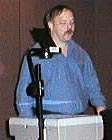 At any rate, you'll find the first (and, to me, best overall) talk written
up on the author's own web site: Homesteading the
noosphere by Eric Raymond was
a fascinating exploration of the reasons that motivate people to give
software away and of the social customs that the community evolved to
protect and reward this gift culture. The presentation was very interactive
and ESR said he would incorporate some of this feedback (notably Paul
Dubois's intuition on "young bachelor predators") in a revised version of
his paper (which he regards as continually evolving anyway).
At any rate, you'll find the first (and, to me, best overall) talk written
up on the author's own web site: Homesteading the
noosphere by Eric Raymond was
a fascinating exploration of the reasons that motivate people to give
software away and of the social customs that the community evolved to
protect and reward this gift culture. The presentation was very interactive
and ESR said he would incorporate some of this feedback (notably Paul
Dubois's intuition on "young bachelor predators") in a revised version of
his paper (which he regards as continually evolving anyway).
The SMS server or why I switched from Tcl to Python
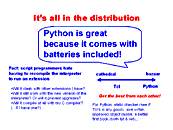 My own talk was, I'm pleased to say, very well received by the
audience. Out of an attendance of about 100, at least 30 came to me
individually over the next couple of days, after the talk itself or at
meals or informal gatherings, to say that they had found it interesting and
entertaining. And my meme of "Python is great
because it comes with batteries included" caught on pretty fast, with other
pythoneers adopting it there and then and reusing it as now-established
jargon (it's now even the title of Cameron Laird's
SunWorld OnLine column
covering the conference). ESR later told me that he had been one of the
reviewers of my paper and had recommended that my talk be given a
"prime-time" spot because he felt it was going to be good. Cool!
My own talk was, I'm pleased to say, very well received by the
audience. Out of an attendance of about 100, at least 30 came to me
individually over the next couple of days, after the talk itself or at
meals or informal gatherings, to say that they had found it interesting and
entertaining. And my meme of "Python is great
because it comes with batteries included" caught on pretty fast, with other
pythoneers adopting it there and then and reusing it as now-established
jargon (it's now even the title of Cameron Laird's
SunWorld OnLine column
covering the conference). ESR later told me that he had been one of the
reviewers of my paper and had recommended that my talk be given a
"prime-time" spot because he felt it was going to be good. Cool!
Contrary to my expectations, though, nobody took up the hacker's selfgen
challenge to produce a Python program that would generate a Tcl program
that would generate the original Python program, though Guido suggested the
variant of writing a self generating program whose text was at the same
time legal Python and legal Tcl.
Mailman
 The next talk, by Ken Manheimer, presented Mailman, a versatile mailing list manager written entirely in Python which has been adopted as the official GNU mailing list software. The administrative interface, both for the list owner and for the individual users, is web-based and looks very pretty and functional. The software looks quite interesting and I intend to give it a try.
The next talk, by Ken Manheimer, presented Mailman, a versatile mailing list manager written entirely in Python which has been adopted as the official GNU mailing list software. The administrative interface, both for the list owner and for the individual users, is web-based and looks very pretty and functional. The software looks quite interesting and I intend to give it a try.
XML
Sean McGrath gave substance to his previous tutorial by presenting a real-life case of XML and Python at work: capturing multi-gigabyte legacy data (Proceedings of the Irish parliament, 600 volumes, 125 feet of shelf space) into a form suitable for electronic publication.

Python: the next 7 years
Guido van Rossum talked (with great modesty) about what he sees in the
future of Python. Dismissing the title as a joke (nobody can predict this
far ahead in computing), he gave a rough schedule of the next few releases:
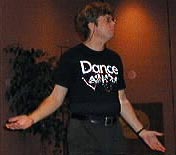
-
1.5.2 in 1998:
- the last of the 1.5 dynasty, minor changes.
-
1.6 in 1999:
- addressing language issues (unicode?) but remaining very compatible
-
2.0 in 2000-2001:
- major changes, probably with some
incompatibilities. Philosophy & look won't change much, but code rewritten
from scratch, probably in C++ (if not Java, if Jim has it his way...)
Tkinter threading is ok on Unix, broken on Windows: "I understand exactly why it hangs, but I have no clue on how to fix it (without hacking Tk to make it work, which I don't want to do)".
JPython
 What's the point of reimplementing Python in Java other than
buzzword compliance? Especially since it will probably run like slow
molasses, if at all? Well, let Jim
Hugunin have a go at it and you'll be impressed. What you get is access
to all the libraries written for Java and portability to any platform that
has a JVM (including browsers, so yes, you can write applets in Python and
they will run without the need for a plugin). But what is most amazing is
the raw speed of Jim's code: not 1/50 or 1/10 but a very respectable half
the speed of CPython!
What's the point of reimplementing Python in Java other than
buzzword compliance? Especially since it will probably run like slow
molasses, if at all? Well, let Jim
Hugunin have a go at it and you'll be impressed. What you get is access
to all the libraries written for Java and portability to any platform that
has a JVM (including browsers, so yes, you can write applets in Python and
they will run without the need for a plugin). But what is most amazing is
the raw speed of Jim's code: not 1/50 or 1/10 but a very respectable half
the speed of CPython!
Another interesting aspect of this work is that it provides Python with
another plausible implementation, which helps immensely in defining what is
language law and what is implementation accident, something that Python
needs to mature, as a real language, beyond the stage of an ad-hoc
brilliant hack. Finally, some of the optimisation techniques pioneered by
Jim (including ML-style type inference) point the way to a potential >10x
(10x, not 10%) performance improvement, possibly at the price of minor
language changes towards partial static typing.
More talks


There was a heavy contingent of presentations (more than half the refereed
papers, actually) about optimising, extending, compiling and otherwise
messing around with the internals of Python. I personally found this
slightly unbalanced, but having said that I particularly enjoyed the talk
by Paul Dubois about a clear, high-level system to write Python extensions
in C++.
The talk by
David
Beazley on the use of Python in a supercomputing environment was very
entertaining, The opening slide was "pornography", i.e. a photograph of a
parallel supercomputer of the sort that programmers can only lust for.

 As part of the Stajano World Tour 1998 I had to leave the conference early
to give a presentation in another continent for the publication of my second book
on Walt Disney comics, so I missed the last couple of presentations
(including an intriguing talk on the Mayan calendar) and, to my greatest
disappointment, the developers' day.
As part of the Stajano World Tour 1998 I had to leave the conference early
to give a presentation in another continent for the publication of my second book
on Walt Disney comics, so I missed the last couple of presentations
(including an intriguing talk on the Mayan calendar) and, to my greatest
disappointment, the developers' day.
Demos and posters
For the demos
session, everybody was crammed into a comparatively small
room. Exhibitors were given either a table or some wall space, depending on
whether they had a demo or a poster, and visitors took turns looking at the
stuff. I presented two posters: Nothing better than a Python
to write a Serpent and VCK: the visual cryptography
kit . I spent the whole session demonstrating and explaining
the two projects to interested groups of visitors, so I didn't get much of
a chance to properly see the work of the other exhibitors, which was a
shame.
 I did however catch a glimpse of Jason
Asbahr's amazing Beyond demo, a video game framework based on a 3D
virtual world similar to a medieval DOOM on steroids, in which the game
logic was controlled by Python. Having been heavily involved in DOOM stuff for years in a
previous life, my jaw dropped.
I did however catch a glimpse of Jason
Asbahr's amazing Beyond demo, a video game framework based on a 3D
virtual world similar to a medieval DOOM on steroids, in which the game
logic was controlled by Python. Having been heavily involved in DOOM stuff for years in a
previous life, my jaw dropped.
I also had a peek at Jeff Bauer's demo of PythonCE
(written by Brian Lloyd, who wasn't there) on various
palmtops. Exciting! Exciting! (I've been carrying a palmtop in my pocket
for years, though I'm trying to stay away from the beasts right now because
of RSI problems.) And Jeff added a remote interpreter so that, as a
developer, you can work on a proper keyboard and screen while genuinely
running stuff on your little CE machine (not just under emulation). He also
started a mailing
list.
People

Meeting all those great Python people face to face was probably the
best reward for coming. I collected a neat little stack of
business cards, including the brilliant fanfold ones from Håkan
Karlsson and Fredrik Lundh of Secret
Labs / Pythonware, makers of PIL, edible little blue dolphins and many other fine things...


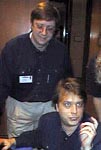
More on IPC7

Back to Frank Stajano's home page at ORL or at the University of Cambridge

 validated (recheck)
validated (recheck)



 with the man. Read
his insightful papers The
cathedral and the bazaar and Homesteading the
noosphere (plus two more in the pipeline). You might also be interested
in the Halloween
documents, about Microsoft's view on the Open Source "threat". Eric is
finally being noticed not just by the press but by the people with the
money: a phone conference was scheduled for the 18th of November for him to
speak to an audience of 75-100 venture capitalists, each worth > 100
M$. Summary: Open Source is better for reliability, cost of ownership,
strategic business risk.
with the man. Read
his insightful papers The
cathedral and the bazaar and Homesteading the
noosphere (plus two more in the pipeline). You might also be interested
in the Halloween
documents, about Microsoft's view on the Open Source "threat". Eric is
finally being noticed not just by the press but by the people with the
money: a phone conference was scheduled for the 18th of November for him to
speak to an audience of 75-100 venture capitalists, each worth > 100
M$. Summary: Open Source is better for reliability, cost of ownership,
strategic business risk.
 Python is younger, less used and less known than Tcl. This is something
that I palpably perceived at the conference, much more so than in the
newsgroup. The user community is quite small, still mostly geeks and very
few big players. Still, I rate it as a good penny-share bet: the language
has the potential to grow into something very successful. It has a more
bazaar-like slant than Tcl, which means that it improves at a faster rate
(if you haven't read Eric Raymond's eye-opening
Python is younger, less used and less known than Tcl. This is something
that I palpably perceived at the conference, much more so than in the
newsgroup. The user community is quite small, still mostly geeks and very
few big players. Still, I rate it as a good penny-share bet: the language
has the potential to grow into something very successful. It has a more
bazaar-like slant than Tcl, which means that it improves at a faster rate
(if you haven't read Eric Raymond's eye-opening  As I discovered at the conference, on the organisational front Python has
the backing of Albert Vezza (ex MIT - Laboratory for Computer Science), now
Guido van Rossum's boss at CNRI. Vezza was behind the X Consortium at MIT
as well as behind the W3C -- he was the one who hired Tim Berners-Lee out
of CERN. Past history shows that he knows how to successfully fertilise,
support and fund major computing projects in the spirit of Open Source. The
fact that he has now started the
As I discovered at the conference, on the organisational front Python has
the backing of Albert Vezza (ex MIT - Laboratory for Computer Science), now
Guido van Rossum's boss at CNRI. Vezza was behind the X Consortium at MIT
as well as behind the W3C -- he was the one who hired Tim Berners-Lee out
of CERN. Past history shows that he knows how to successfully fertilise,
support and fund major computing projects in the spirit of Open Source. The
fact that he has now started the 


 At any rate, you'll find the first (and, to me, best overall) talk written
up on the author's own web site:
At any rate, you'll find the first (and, to me, best overall) talk written
up on the author's own web site:  My own talk was, I'm pleased to say, very well received by the
audience. Out of an attendance of about 100, at least 30 came to me
individually over the next couple of days, after the talk itself or at
meals or informal gatherings, to say that they had found it interesting and
entertaining. And my
My own talk was, I'm pleased to say, very well received by the
audience. Out of an attendance of about 100, at least 30 came to me
individually over the next couple of days, after the talk itself or at
meals or informal gatherings, to say that they had found it interesting and
entertaining. And my  The next talk, by Ken Manheimer, presented Mailman, a versatile mailing list manager written entirely in Python which has been adopted as the official GNU mailing list software. The administrative interface, both for the list owner and for the individual users, is web-based and looks very pretty and functional. The software looks quite interesting and I intend to give it a try.
The next talk, by Ken Manheimer, presented Mailman, a versatile mailing list manager written entirely in Python which has been adopted as the official GNU mailing list software. The administrative interface, both for the list owner and for the individual users, is web-based and looks very pretty and functional. The software looks quite interesting and I intend to give it a try.


 What's the point of reimplementing
What's the point of reimplementing 
 There was a heavy contingent of presentations (more than half the refereed
papers, actually) about optimising, extending, compiling and otherwise
messing around with the internals of Python. I personally found this
slightly unbalanced, but having said that I particularly enjoyed the talk
by Paul Dubois about a clear, high-level system to write Python extensions
in C++.
The talk by
There was a heavy contingent of presentations (more than half the refereed
papers, actually) about optimising, extending, compiling and otherwise
messing around with the internals of Python. I personally found this
slightly unbalanced, but having said that I particularly enjoyed the talk
by Paul Dubois about a clear, high-level system to write Python extensions
in C++.
The talk by  As part of the Stajano World Tour 1998 I had to leave the conference early
to give a presentation in another continent for the publication of
As part of the Stajano World Tour 1998 I had to leave the conference early
to give a presentation in another continent for the publication of  I did however catch a glimpse of
I did however catch a glimpse of 





